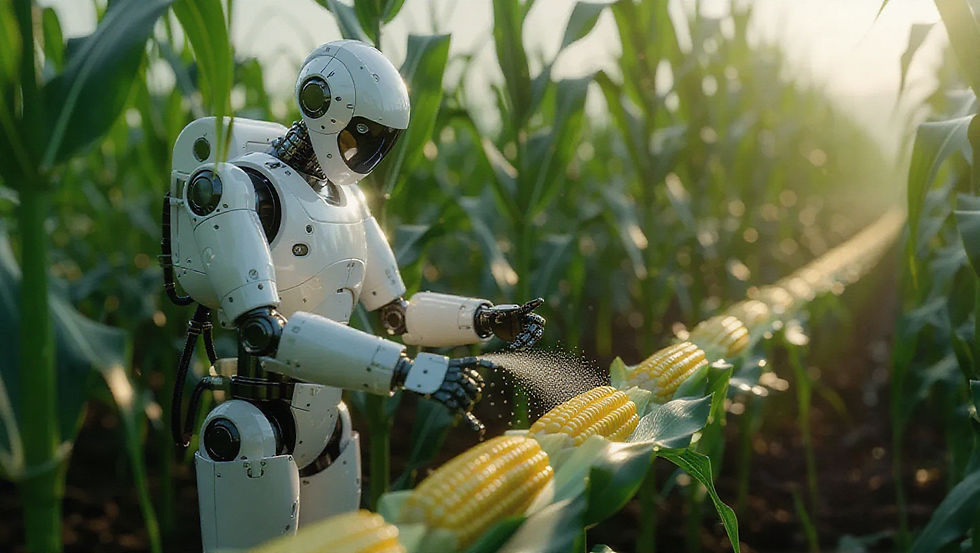The Role of Robotics in Precision Farming
- CYOL Press Release

- May 30
- 5 min read
By CYOL Staff
The world of agriculture is changing fast, and robotics is at the heart of this transformation. What once seemed like science fiction machines doing the work of humans in the field is now a real, everyday part of modern farming. This shift, often called the Agri robotics revolution, is not only improving how farms operate, but also helping them grow and stay competitive in a fast changing world.
Today, robots do everything from pulling weeds to harvesting delicate fruits, scouting for pests, and applying fertilizer. These are no longer experimental machines. They are proven tools that help farmers save time, reduce costs, and produce better yields. Let us explore how smarter machines are making smarter fields and how platforms like CYOL lead the way in making it all work together.

Smarter Machines for Smarter Fields
Weeding Robots
One of the biggest challenges in farming is weed control. Traditionally, this meant a lot of manual labour or widespread use of herbicides, which can be expensive and harmful to the environment. Now, weeding robots are changing the game.
These machines use computer vision, a type of artificial intelligence that lets them "see" and recognize plants. They can tell the difference between crops and weeds and then remove only the unwanted plants. Some robots use mechanical tools, like small blades, to cut weeds out of the soil. Others apply tiny doses of herbicide directly onto the weeds, using much less chemical than traditional methods.
This targeted weeding helps protect the crops, reduces the use of chemicals, and is better for the environment overall. It is also much faster and more consistent than doing the job by hand.
Harvesting Robots
Harvesting is one of the most labour intensive parts of farming. It requires speed, precision, and a lot of human effort, especially with crops like fruits, which must be picked at just the right time. This is where harvesting robots come in.
These robots are equipped with robotic arms and advanced sensors. They can detect the ripeness of fruits, pick them gently to avoid bruising, and work around the clock, even at night. From strawberries to apples to tomatoes, robots are now helping farmers get the harvest in faster and with less waste.
For crops where timing is critical, robotic harvesting ensures that produce is picked at peak quality. This leads to better market value, less spoilage, and lower labour costs.
Scouting Robots
In precision farming, data is everything. The more a farmer knows about the field, the better decisions they can make. But walking every row and inspecting each plant manually is time consuming and often incomplete. Scouting robots provide a much smarter solution.
These robots come in two forms: ground based rovers that drive through fields and drones that fly above them. Both types collect valuable information on things like:
Plant health
Soil moisture
Pest presence
Crop growth stages.
They provide high resolution, plant by plant data, which is far more detailed than human observation. This allows farmers to spot problems early, treat specific areas of the field, and make better decisions based on real time insights.
Micro Spraying Units
Another great use of robotics in farming is micro spraying, the precise application of fertilizers or pesticides only where and when needed. These smart sprayers are programmed to work with field maps, crop models, and sensor data. They avoid blanket spraying and instead treat just the right areas with exact doses.
This approach offers many benefits:
Reduced chemical use.
Lower input costs
Less environmental harm
Improved crop performance
By delivering exactly what each part of the field needs, micro spraying robots make farming more efficient and sustainable.

Labour Savings vs. Capital Costs: Calculating ROI
Agricultural robots can indeed be expensive to buy and set up. But the return on investment (ROI) is becoming clearer every season. Robots bring long term savings, better performance, and stronger reliability, especially in areas with labour shortages or unpredictable weather.
Here are some of the main ways robots deliver ROI:
1. Reduced Labour Dependency
With robots taking on tasks like weeding, spraying, and harvesting, farmers do not need to rely as heavily on seasonal labour, which can be hard to find and costly.
2. Faster Task Completion
Robots can work 24 hours a day, rain, or shine, without breaks. This means that time sensitive tasks get done faster and more efficiently.
3. Lower Input Costs
Because robots apply inputs like fertilizer and herbicide only where needed, farmers save money by reducing waste.
4. Higher Yields
Robots perform tasks more consistently and on time, which helps crops grow better and reduces losses.
5. Long Term Cost Reduction
Tasks like weeding and spraying are repetitive and ongoing. Once robots are set up, they can manage these jobs continuously without the need for constant supervision or retraining.
More than just money, farmers should also think about ROI in terms of:
Risk reduction (avoiding crop loss due to delays or labour shortages)
Scalability (growing the farm without adding more workers)
Resilience (being able to keep operations running during tough times)
Seamless Integration: Robots + Farm Management Systems
A robot on its own is powerful, but a robot that works with other systems is even better. For modern farms, which means connecting robots to digital platforms that manage every part of the operation.
Successful robotic systems work together with:
GPS and field maps for location tracking and planning
Variable rate application systems for precise input control
Soil and weather sensors to adjust tasks based on conditions.
Crop growth models to understand when to act.
Machine telematics to monitor performance and maintenance.
This integration allows robots to become part of a larger digital ecosystem, rather than just stand alone machines. Farmers do not have to replace their entire equipment fleet; they just need to upgrade with smart, interoperable systems that talk to each other.

CYOL’s Robotics Interface: Real Time Sync, Real World Impact
At CYOL, we understand that robotics is not just about hardware; it is about connecting machines and data. That is why we have developed a powerful robotics interface that links autonomous field units with the CYOL digital dashboard.
Here’s how CYOL’s system supports robotic integration:
Plug and Play Compatibility
CYOL works with many of the top Agri robot brands. You do not need custom software; most machines can connect instantly and start working with the CYOL platform.
Live Task Monitoring
Through CYOL, farmers can track what their robots are doing in real time. This includes location, task progress, efficiency, and performance data, all from one screen.
Data Feedback Loop
Every pass a robot makes adds more data to the system. This information is used to update crop models, adjust future recommendations, and improve planning.
Command Center Control
Farmers can schedule, assign, and monitor tasks directly from the CYOL dashboard. The system even adapts based on real time weather data, soil sensors, or changes in field conditions.
By removing data silos and creating a seamless link between field operations and digital management, CYOL turns robots into smart, responsive team members on the farm.
Precision farming is no longer about collecting data, it is about executing tasks based on that data. With the power of robotics, farmers can now act with speed, accuracy, and consistency that was never possible before.
And with platforms like CYOL, they do not have to do it alone. Our tools connect robots, sensors, and crop data into one smart system that helps farms grow stronger, more sustainable, and more profitable.
The Agri robotics revolution is not the future, it is happening right now. And with CYOL, every farmer can be part of it.




























Comments